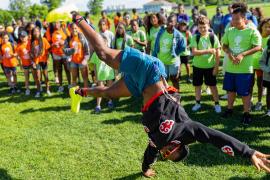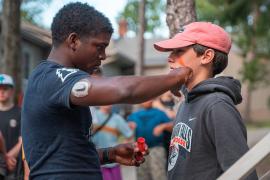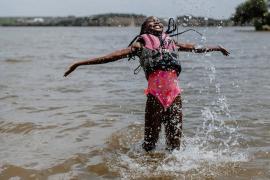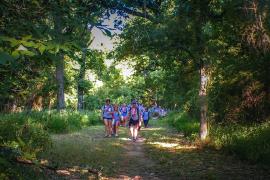Note: This blog posts focuses on accommodations for programming, operational, and senior level staff rather than for frontline staff who are required to sleep in the cabins with campers. The difference here is more private-style housing that doesn’t require supervision of campers.
Have you ever thought about what senior-level staff think of their accommodations at camp? Does reality match what is anticipated? Does lodging exceed staff expectations, or are they left hoping that the summer will end quickly so they can return home to their own bed?
Don't get us wrong — we know camp is about more than your accommodations! The friendships, the memories, and the experiences, to name a few. However, there are some considerations offered here regarding staff living space that could help with recruitment and retention. Paying attention to these details show that you care about your staff. After all we know that happy staff equals happy campers!
This post highlights the "Four C's" of staff housing:
- Comfort
- Connectivity
- Community
- Cleanliness
Comfort
After a long day’s work, coming back to a place where one can rest, relax, and recharge is key.
Elements that can help make a space comfortable include:
- Air circulation (ceiling fan, air conditioning)
- Kitchenette (microwave, sink, refrigerator, coffee pot, counter space)
- Furniture (sofa or chair and a table/desk)
- Artwork (can be as simple as past camp photos)
- Access to a laundry facility (or laundry service provided)
Connectivity
No, connectivity is not all about technology (however, that too is important and will be addressed later). It is about being able to connect with the larger camp community and/or coworkers to build comradery and relationships. With a sense of connectivity, staff feel as if they belong and are important to the mission. This can go a long way to them feeling appreciated, proud, and successful throughout the camp season. Things to consider:
- The location of staff housing on your property:
- At the entry (can also act as security)
- In the heart of camp (can be extra eyes, ears, and hands)
- In their own separate staff village (offers more privacy)
- The flexibility of the space(s) for:
- Single staff
- Married staff
- Staff with families
- The provision for technology:
- To increase and improve workflow efficiencies (for camp duties, school requirements, and non-camp job responsibilities)
- To allow for personal connections (family and friends back home)
Community
Good, working relationships allow the staff to consider each other as friends and not just co-workers. Providing staff with a sense of place allows the workspace (the camp) to feel welcoming and encouraging, kind of like home:
- Private space (a place to call their own and escape should they need a few minutes of peace and quiet)
- Common space (think of this as a typical living room in your home)
- Outdoor common spaces (a fire circle or place to hang a hammock)
- Space(s) for staff only (a staff lounge or alternate space that is off limits to campers and offers the staff a different kind of space than anything else at camp)
- Places that encourage team building (a game room, place to play cards or tabletop games)
Cleanliness
Let's be honest, we know camp in general can be a bit hectic with busy days and changing weather conditions (cool nights and warm days). Making sure staff housing is as welcoming as the camper cabins is important to making a good first impression. Once staff move in, it is up to each individual to keep their space clean and tidy!
- Make it functional (spaces that can accommodate all ages and lifestyles with access to the bathroom and commons spaces without needing to cross through someone else’s sleeping space)
- Pay attention to deferred maintenance (fix the leaky toilet before it causes the floor to warp)
- Provide safe spaces (places where people are not subject to biases, discrimination and criticisms; places where people can feel confident)
- Plan for adequate storage (dressers, cubbies, closet space, bins, etc.)
While the items listed here are just a few ideas on what can make for welcoming staff accommodations, you may have others that could help as well. Achieving all these items at once may seem like a daunting task. However, accomplishing a few at a time, with a goal to add or upgrade one or more each season will improve your overall staff accommodations year after year. We recognize that when it comes to planning for new or improved facilities it can take more than a few months and more than likely more than a few years.
Your staff are key to having a great camp. It may be wise to ask them which of the four Cs matter most and prioritize your improvements based on their general feedback. The quality of staff lodging can play an important role in recruiting the best staff possible and having them return for future summers.
This blog was written on behalf of Project Real Job whose purpose is to support camps in their efforts to recruit, hire, and retain staff.
Jackie Kaminsky has extensive master planning and landscape architecture experience and has been involved in a wide variety of project types with Domokur Architects. She quickly develops an understanding of projects goals, synthesizing and analyzing project priorities, and always with an eye on project budgets and schedule. With a methodical and comprehensive approach, Jackie guides projects to success by fully delving into challenges and carefully tailoring design solutions, while applying her knowledge and skills to meet the requirements of each unique client and project. Her skills include creative thinking and an appreciation that there are always multiple ways to solve a problem. Jackie can be reached at [email protected] or [email protected].
Photo courtesy of Wisconsin Lions Camp in Rosholt, Wisconsin
The views and opinions expressed by contributors are their own and do not necessarily reflect the views of the American Camp Association or ACA employees.




